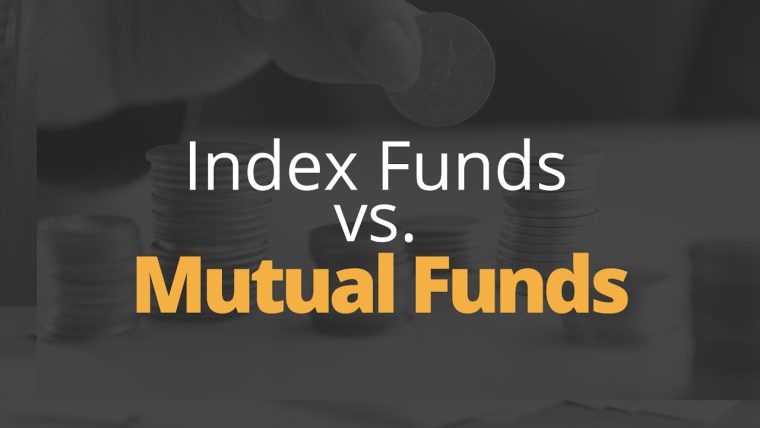Differences Between Index Funds and Mutual Funds

The age-old debate regarding active mutual fund vs index mutual fund in terms of better returns seems to be never-ending. While some prefer active investing based on past performance, however, data suggests that more and more investors are shifting their base to passive or index mutual funds. The distinction between active mutual funds and index mutual funds lies in their management style, investment objective and cost.
Take a closer look to understand the differences between index funds and mutual funds before investing. Read on!
What are Mutual Funds?
An active mutual fund is a popular instrument that pools investments from numerous individuals to invest in various securities. These include stocks, bonds, cash and cash derivatives, among others. A fund manager decides in which asset class to invest. Since an active fund manager is involved, the cost of active mutual funds or expense ratio usually falls under the higher bracket.
What are Index Funds?
An index fund is a type of passive fund, which tracks popular benchmark indices such as Nifty 50 and Sensex to generate near-identical returns. These are passive funds because there’s no intermediary in the form of a fund manager involved who decides the allocation of the fund. The index fund invests in its underlying index’s units in the exact same proportions to produce similar returns. Since, there’s no role of a fund manager in index funds, the cost or expense ratio of such funds is low.
How do Mutual Funds Work?
All actively managed funds such as equity mutual funds, fund of funds, debt mutual funds, and hybrid funds need a dedicated fund manager/management team. This fund manager/ management team, based on their expertise and research, decides which stock stays in the fund based on its performance.
Here, the work of an active fund manager is to pick and choose stocks/investments for the funds that outperform their stated benchmark or index. With a team of analysts and researchers, the fund manager will ‘actively’ buy, hold and sell stocks to try to achieve this goal.
How do Index Mutual Funds Work?
Index funds mirror the holdings of whatever index they track. Meaning, the NAV (Net Asset Value) steers along the index it tracks. As mentioned earlier, fund managers don’t play an active role in index funds. Hence, if the market indices drop, the NAV also drops in the same manner. Similarly, if the indices go in the upper trajectory, the NAV also goes up.
Also Read
Differences Between Index Funds and Mutual Funds
Take a look at these key differences between index funds and mutual funds:
| Parameters | Active Mutual Funds | Index Funds |
| Fund Allocation & Management | Professional fund managers of active mutual funds use their expertise to allocate assets on the basis of the market scenario. | Index mutual funds track renowned indices such as the Nifty50 and the fund managers allocate funds to the constituent units in identical proportions. |
| Expense Ratio | Actively managed funds require continuous analysis on the fund manager’s part which is why there’s a higher expense ratio. | Index funds involve the negligible involvement of a fund manager and, hence, come with lower expense ratios. |
| Fund Performance | The goal of active mutual funds is to beat market performance. This is why active funds tend to outperform in a bearish market most of the time. | Index funds don’t have the potential to outperform the market. However, they are more efficient in minimising losses when markets are underperforming. |
| Risk Factor | Risk in actively managed mutual funds revolves around the market capitalisation of companies. The returns also depend on the fund manager’s decisions. | Index funds are risky because of tracking errors, leading to returns different from their underlying index. However, the risk factors are less in number. |
| Objective | Actively managed mutual funds strategically select stocks which have the potential to yield higher returns as the objective is to outperform the market. | An index fund simply mirrors the performance of an index; the objective is to yield market-related returns. |
1. Fund Allocation and Management
Professional fund managers of mutual funds allocate assets on the basis of the market scenario. Therefore, the performance of these funds relies entirely on a fund manager’s knowledge and expertise.
On the other hand, since index funds try to replicate the returns of the underlying benchmarks, they do not require active management. Index mutual funds track renowned indices such as the Nifty50 and the fund managers allocate funds to the constituent units in identical proportions.
2. Expense Ratio
Actively managed funds require continuous and profound industry analysis on a fund manager’s part which is why there’s a higher expense ratio. After that, they pick suitable assets for fund allocation to ensure maximum returns.
In contrast, index funds involve the negligible involvement of a fund manager and, hence, come with lower expense ratios.
3. Fund Performance
The goal of active mutual funds is to beat market performance. This is why active funds tend to outperform in a bearish market most of the time. However, large-cap funds have been underperforming the index since 2018.
In contrast, index funds don’t have the potential to outperform the market. However, passive funds have beaten indices as they’re tracking the returns of the underlying indices over 80% of the time. Index funds have also been more efficient in minimising losses when markets are underperforming, and they deliver better returns than large-cap funds.
4. Risk Factor
There can be instances when the fund managers might not select stocks in the best possible way, thus contributing to the risk. Risk in actively managed mutual funds also revolves around the market capitalisation of companies. Small and medium-cap funds, for instance, involve aggressive investment strategies and are more volatile than large-cap funds.
Index funds are also risky because of tracking errors, leading to returns different from their underlying index. However, the risk factors are less in number than actively managed mutual funds.
5. Objective
Investors who want higher-than-average market returns may find investing in mutual funds more profitable. Actively managed funds strategically select stocks which have the potential to yield higher returns as their objective is to outperform the market.
On the other hand, an index fund simply mirrors the performance of an index. The objective is to yield market-related returns; however, this fund also proves to be profitable during bearish markets.
Index Fund vs. Mutual Fund – Which One to Consider?
Below are a few pointers to help you select what’s better:
1. Nature of the Fund
One of the biggest benefits of active mutual funds is that it has the chance of outperforming the market plus it is managed by professional fund managers which makes them more efficient. Index funds are not managed by active fund managers. Index funds still have the chance to perform better than active funds. It totally depends on your financial goals and the nature of the fund you want to invest in.
2. Risk Involved
Index funds are a better option for beginners who are starting their investment journey or any investor who has a lesser risk tolerance. Active funds are better suited for seasoned investors with moderate to high-risk tolerance.
3. Performance
It is highly recommended to check the past performance of the funds you want to invest in such that you know what you are opting for. For active funds, it is good to track the performance of the fund manager. For index funds, check past performance before making an investment decision.
4. Long-term Investments
For long-term investments, it is good to go for a mix of active and passive investments. Investors who are starting their investment journey can allocate most of their investments in passive funds and investors with moderate to high-risk appetites can opt to invest more in active funds than passive funds.
The choice of funds completely depends on the investor’s risk tolerance, financial goals and beliefs. Some investors might think that the fund managers have the ability to perform better than passive funds but some might consider passive investment because of the low expense ratio. It is always advisable to research before investing in order to make an informed decision.
Also Read
Should You Invest in Mutual Funds Actively or Passively?
An actively managed fund involves the active involvement of fund managers. They put their incessant effort into analysing the best stocks for their fund and ensuring maximum yield generation for the investors.
On the other hand, a passively managed fund tries to replicate the returns of stock indices to maximise return. It doesn’t require any active management; fund managers remove or replace non-performing funds and shuffle the portfolio allocation as per the underlying indices.
Most mutual funds are actively managed; however, an index mutual fund is passively managed. Thus, if you want to generate returns after analysing the market performance of companies, and if your investment strategies get aligned with the fund manager’s active participation, an actively managed fund might be the option for you.
However, if you want a hands-off approach and wish to generate replicated returns of indices, a passively managed fund might be the ideal choice.
Final Word
Taking the above points into consideration can help in effective comparison before investing. Potential investors must ensure their choice aligns with their financial goals to ensure adequate returns.
If you are looking for a wide range of low-cost index funds, you could try Navi Mutual Fund. To get started, just download the Navi App.
FAQs
Ans: Similar to other AMCs, Navi calculates the expense ratio as a percentage of the total expenses against the total sum of the average annual AUM. You can refer to our article on what is expense ratio to understand the calculation and its impact on mutual funds.
Ans: Index funds have a historical record of outperforming actively managed mutual funds. However, this should not be the sole factor influencing your choice while comparing index funds vs mutual funds, as some expert fund managers can assure you substantial returns against actively managed mutual funds.
Ans: Individuals new to mutual fund investments can achieve better risk mitigation with index funds as they take high performing benchmarks such as the Nifty 50 as their investment framework, replicating the index’s performance. On the other hand, active mutual funds require greater involvement and understanding of market trends on the investor’s part.
Ans: You can invest in active or index mutual funds through any brokerage account; stock exchange platforms or any other channels.
Ans: According to news, it was seen that the active mutual outperformed its index rivals in the past year. But mutual funds are subjected to market changes and the result may not always be the same.
Want to put your savings into action and kick-start your investment journey 💸 But don’t have time to do research? Invest now with Navi Nifty 50 Index Fund, sit back, and earn from the top 50 companies.
Disclaimer: Mutual Fund investments are subject to market risks, read all scheme-related documents carefully.
This article has been prepared on the basis of internal data, publicly available information and other sources believed to be reliable. The information contained in this article is for general purposes only and not a complete disclosure of every material fact. It should not be construed as investment advice to any party. The article does not warrant the completeness or accuracy of the information and disclaims all liabilities, losses and damages arising out of the use of this information. Readers shall be fully liable/responsible for any decision taken on the basis of this article.

10 Best Demat Accounts in India for Beginners in 2023
Creation of Demat accounts revolutionised the way trades were conducted at the stock exchanges. It... Read More »10 Best SIP Plans for 1000 Per Month in India 2023
Systematic Investment Plan (SIP) is an investment style or route with which you can invest a fixed ... Read More »How to Invest in Mutual Funds in India – Easy Steps
Mutual funds can be an excellent way to diversify your portfolio and gain exposure to a wide range ... Read More »20 Best Nifty 50 Index Funds in India to Invest in April 2023
What is the Nifty 50 Index Fund? Nifty 50 index funds are a type of passively-managed equi... Read More »Asset Management Company (AMC) – Types and Benefits
What is an Asset Management Company (AMC)? Asset Management Company or AMC is a financial ... Read More »10 Best Gold Mutual Funds to Invest in India (April 2023)
Gold Mutual Funds are funds that invest in gold and gold-related assets such as bullion, coin... Read More »20 Best Flexi Cap Mutual Funds to Invest in India 2023
Flexi-cap funds are mutual fund schemes that aim to invest in stocks of companies across market cap... Read More »Best SIP Plans for 15 years – Top 10 SIP Plans to Invest in India 2023
A systematic investment plan (SIP) could be a convenient mode or style of investing in mutual funds... Read More »10 Best SIP Plans for 1 year Investment in India 2023
There has been a massive surge in SIP or Systematic Investment Plan investors in recent years. As p... Read More »10 Best SIP Plan for 3 Years in India to Invest in 2023
SIP or Systematic Investment Plan helps bring investment discipline in an investor’s life. It’s... Read More »10 Best SIP Plan for 10 years India in 2023 – Returns and Performance
Ask any beginner mutual fund investor and most of them would tell you that their preferred mode of ... Read More »10 Best SIP Plans for 5 years in India to Invest in 2023
Systematic Investment Plan (SIP) could be an effective investment mode if you want to invest a fixe... Read More »Top 10 Chit Fund Schemes in India in 2023
Chit funds are one of the most popular return-generating saving schemes in India. It is a financial... Read More »10 Best Gold ETFs in India to Invest in April 2023
Gold ETFs or Gold Exchange Traded Funds are passively managed funds that track the price of physica... Read More »10 Best Demat Accounts in India for Beginners in 2023
Creation of Demat accounts revolutionised the way trades were conducted at the stock exchanges. It... Read More »20 Best Index Funds to Invest in India in April 2023
What is an Index Fund? An index fund is a type of mutual fund or exchange-traded fund (ETF) that... Read More »Best Arbitrage Mutual Funds to Invest in India in April 2023
Arbitrage funds are hybrid mutual fund schemes that aim to make low-risk profits by buying and sell... Read More »10 Best SIP Plans in India to Invest in April 2023
What is SIP? SIP or Systematic Investment Plan is a method of investing a fixed amount in ... Read More »10 Best Corporate Bond Funds in India to Invest in April 2023
Corporate bond funds are debt funds that invest at least 80% of the investment corpus in companies ... Read More »10 Best Bank for Savings Account in India [Highest Interest Rate 2023]
Savings account is a type of financial instrument offered by several banks. It lets you safely depo... Read More »

































